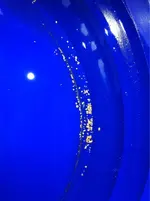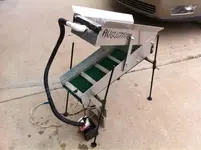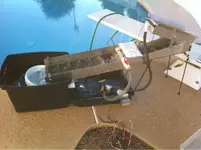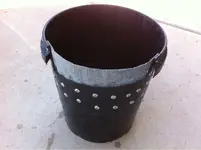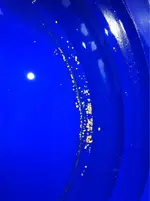... I'd like to see something that can handle 12 yards an hour classified to 1/2 inch. If that gold well can go there you may have hit my holy grail.

On a side note, the gold well is not the first sluice to use that design. I've got some 1870's wooden Chinese sluice boards in the backyard that were built on the same principle. They used that design to clean up the left over tailings from previous mining because it could catch the small stuff that was lost from the inefficient Long Toms that were common at the time.
I'm pretty sure their bigger sluices could handle 12 yards an hour and more. I'll try to make time to take a picture of them in the next few days so you can see the similarity.
Here is a link to a video of a guy processing 20 buckets of material in 14 minutes classified to 1". He is not utilizing the full capacity of the sluice as you will notice him pouring the dirt down the center of the sluice and the sides are not getting any dirt. He also walks away and during this time there is no material going through the sluice. From the looks of it he is pushing the sluice at around 75% max for the section he is feeding. You can do the math. There is another video in that group in which he describes and shows what he's seeing in his pan.
HM Research - Manufacturer of the Gold Well Vortex Drop Riffle Sluice
And here is a link to test results done by Gary Smith as well as his references.
HM Research - Manufacturer of the Gold Well Vortex Drop Riffle Sluice
The GPAP did a field test of the 6" unit early this year. Here is a link to those videos.
HM Research - Manufacturer of the Gold Well Vortex Drop Riffle Sluice[
There are two videos of panning. One is a panning test of the tailings in which no gold was found (this was repeated 20 times, once for each bucket processed at the test, and in all the tests, there was nary one speck of gold found in the tailings.) The other is of panning the gold out of the Gold Well's concentrates. As well as the introductory video of the first test itself.
The chinese riffle boards did not employ a spiral pocket, or alternating slots and spirals. As a result they loaded up rapidly and once full, had very little exchange in the pockets, and so had to be emptied frequently, resulting in a large quantity of concentrates at the end of the day. But during the time the pockets (simple holes) were not full they did indeed work well. The Gold Well pockets constantly empty the top 1/3 of the pocket allowing long runs, and at the end of the day a cup or so of concentrates in the big units. Multiple sluices may be attached side by side for larger operations. Two 12" units would process a huge amount of material.
As for the B.S. I won't get back into the details except to say that I am an honest man. I am working hard, and I do not make enough out of selling these sluices to suffer insults on my integrity, not when they are posed in a public forum and I am called (or those associated with my company) a liar, fraud, a cheat and a homosexual, IN THOSE WORDS! There are certain things I will NOT tolerate and most honorable men would not. What was seen on T-net was the result of that issue spilling over from the GPAA forums here. And then people who had no clue how it had all started, jumping into the fray on the side of the original offenders.
The Gold Well does in fact work superbly, yet have seen no apology from those who falsely accused me publicly of those things. To put to rest the fraud aspect once and for all, you will see it on TV. Stay tuned for the new season of a favorite mining show in January. After that what it does and does not do will for the most part be history so to speak. Here are a few pics to enjoy. The first, some gold collected in a few hours, and the 2nd a picture of a 12" highbanker munching down on those horrible sands in Nome, AK!








